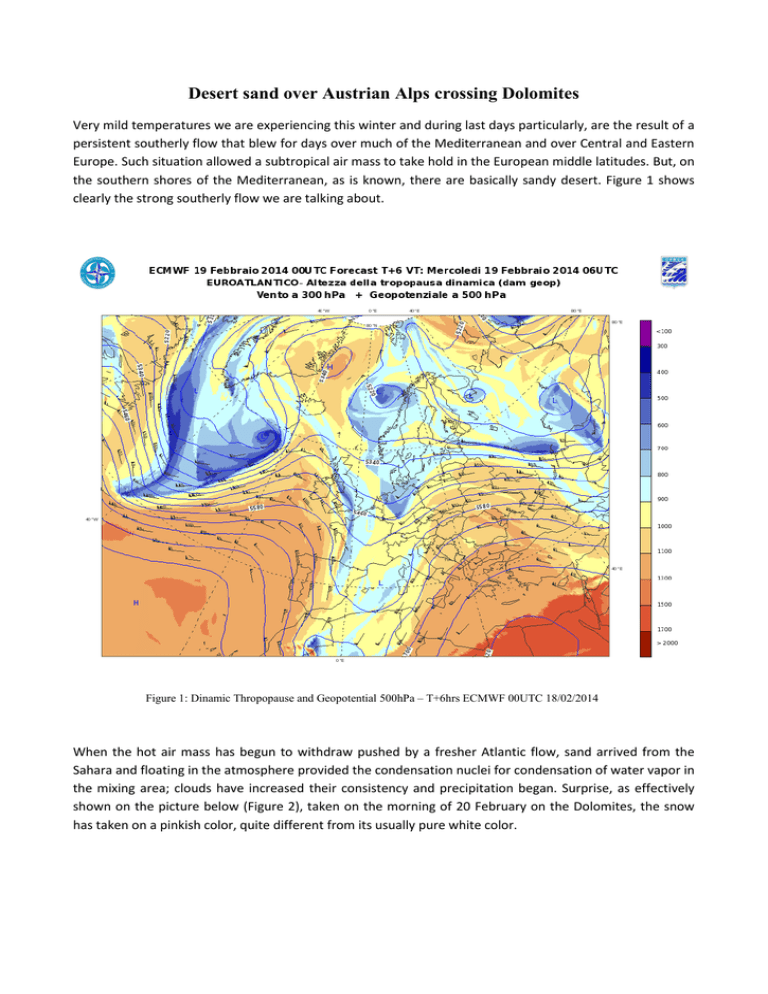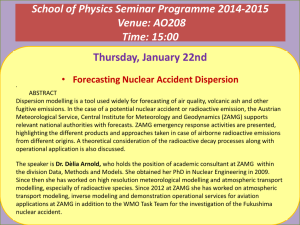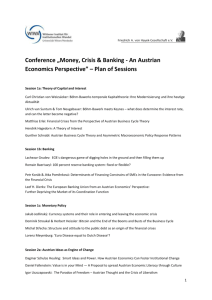Desert sand over Austrian Alps crossing Dolomites
advertisement

Desert sand over Austrian Alps crossing Dolomites Very mild temperatures we are experiencing this winter and during last days particularly, are the result of a persistent southerly flow that blew for days over much of the Mediterranean and over Central and Eastern Europe. Such situation allowed a subtropical air mass to take hold in the European middle latitudes. But, on the southern shores of the Mediterranean, as is known, there are basically sandy desert. Figure 1 shows clearly the strong southerly flow we are talking about. Figure 1: Dinamic Thropopause and Geopotential 500hPa – T+6hrs ECMWF 00UTC 18/02/2014 When the hot air mass has begun to withdraw pushed by a fresher Atlantic flow, sand arrived from the Sahara and floating in the atmosphere provided the condensation nuclei for condensation of water vapor in the mixing area; clouds have increased their consistency and precipitation began. Surprise, as effectively shown on the picture below (Figure 2), taken on the morning of 20 February on the Dolomites, the snow has taken on a pinkish color, quite different from its usually pure white color. Figure 2: Pink snow over Dolomites; in the picture footsteps of wild fauna too (Credit to Carlo Colarieti Tosti) Pink snow then, but not only. During an Exchange of information and technical advice with colleagues from various European Weather Services (frequent practice, especially in particularly interesting weather situations), a fellow of the Austrian Weather Service (www.zamg.ac.at) has shared with us some air quality measurements made February 19 at the high-altitude observatory of Sonnblick, which is 3111 meters above mean sea level in the heart of the Austrian Alps just a few kilometers from the border with Italy, that is in proximity of the Dolomites. In their measurements, it was observed a peak concentration of sand and black carbon (a pigment produced by the combustion of heavy oil products): not just microparticles of natural origin, but also particulate matter from combustion, PM10 present case, as is clearly shown by the graph of Figure 3. Figure 3: Powder and PM10 concentration in the atmopsphere (upper panel) e total rainfall (below) (credit to ZAMG) In conclusion, again thanks to the kind cooperation of the Austrian Weather Service, a beautiful picture of the Alps, in which the lack of transparency of the air due to the large amount of particulate matter in suspension is evident, just before the onset of the snowfall that settled it on the ground (Figure 4). Figure 4: View from Sonnblick Observatory (credit to ZAMG) Thanks to our colleague Christian Csekits of Austrian Central Meterological Institute (ZAMG) for his kind cooperation.


